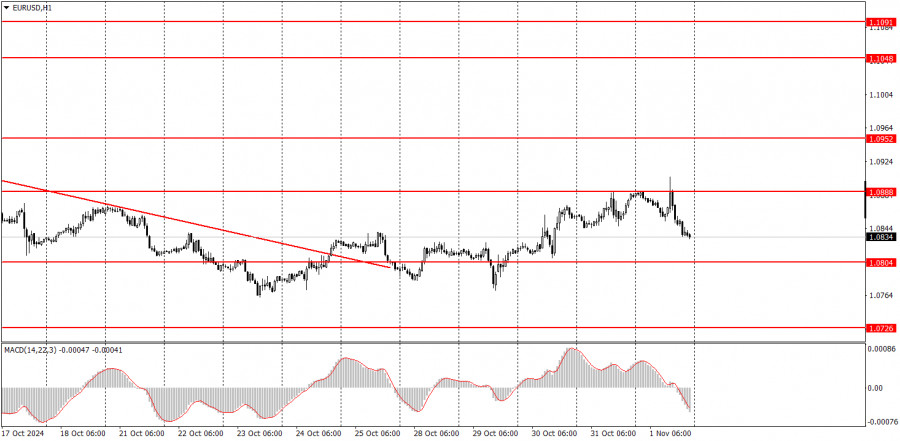Analysis of Friday's Trades:
1H Chart of EUR/USD Pair

The EUR/USD currency pair displayed interesting movements on Friday, allowing for several important conclusions. The key report of the day and the week, Nonfarm Payrolls, failed dramatically. Only 12,000 new jobs were created in October. Additionally, the ISM Manufacturing PMI also fell short. Despite this, the U.S. dollar appreciated by the end of the day. Such movement is illogical, suggesting that we might expect the continuation of the correction next week. However, as often noted, the euro should only fall in the medium term. The market has already priced in the entire or almost entire cycle of monetary policy easing in the U.S., so it doesn't matter how quickly the Federal Reserve will lower rates now. This may explain the dollar's growth on Friday. If so, the pair has formally corrected and can continue its medium-term decline.
5M Chart of EUR/USD Pair

On the hourly timeframe, the EUR/USD pair continues to correct after a month-long decline. At least, there are some grounds for the euro to rise. We believe the correction is unlikely to be strong, as continuous supportive news is required for the euro. Even then, such news may not always benefit the euro, given that the market is now set on buying the dollar.
On Monday, novice traders can trade around the 1.0845-1.0851 area. The price has consolidated below this area, allowing for a potential continuation of the decline.
On the 5-minute timeframe, consider the following levels: 1.0678, 1.0726-1.0733, 1.0797-1.0804, 1.0845-1.0851, 1.0888-1.0896, 1.0940-1.0951, 1.1011, 1.1048, 1.1091, 1.1132-1.1140. No significant events are planned for Monday in the U.S. or the Eurozone. We will watch to see if the pair can remain below the 1.0845-1.0851 area, allowing it to continue falling.
Basic Trading System Rules:
- The strength of a signal is determined by the time it takes to form (whether a bounce or breakthrough of a level). The quicker the formation, the stronger the signal.
- If two or more trades have been made near a level due to false signals, any further signals from that level should be ignored.
- In a flat market, a pair can generate many false signals or none at all. In any case, it's best to stop trading at the first signs of a flat market.
- Trading occurs between the start of the European and middle of the US sessions, after which all trades should be manually closed.
- On the hourly time frame, it's recommended to trade MACD indicator signals only when there is good volatility and a trendline or trend channel confirms a trend.
- If two levels are too close together (5 to 20 pips apart), they should be treated as support or resistance areas.
- After the price moves 15 pips in the intended direction, set the Stop Loss to breakeven.
What's on the Charts:
Support and Resistance Levels: Levels that serve as targets for opening buys or sells. Take Profit levels can be placed around these areas.
Red Lines: Channels or trend lines that indicate the current trend and the preferred trading direction.
MACD Indicator (14,22,3): Histogram and signal line—an auxiliary indicator that can also be used as a source of signals.
Major speeches and reports (always found in the news calendar) can significantly impact currency pair movements. Therefore, it's advised to trade cautiously or exit the market during their release to avoid sharp price reversals against prior movements.
Beginners trading on the forex market should remember that not every trade will be profitable. A clear strategy and money management are the keys to success in long-term trading.
The material has been provided by InstaForex Company - www.instaforex.com #














 Download NOW!
Download NOW!
No comments:
Post a Comment